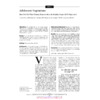 |
|
Lecture Notes | Approved: 7 years ago | 100.23 kB | Comments: 0
...AdolescentVegetariansHowWellDoTheirDietaryPatternsMeettheHealthyPeople2010Objectives?CherylL.Perry,PhD;MaureenT.McGuire,PhD;DianneNeumark-Sztainer,PhD,RD;MaryStory,PhD,RDToexaminewhetheradolescentvegetar-iansweremorelikelythannonvegetarianpeerstomeetthedietaryrecommendationsoftheHealthyPeople2010objectivesandtoexaminedifferencesinothernutrientsbetweenthese2groups.Atotalof4746adolescentsfrom31middleandhighschoolsintheTwinCitiesareaofMinnesota.Datawerecollectedviaself-reportsurveys,withastudentre-sponserateof81.5%.Urbansecondaryschools.Participantswereequallydividedbysex.Themeanagewas14.9years;34.3%wereinjuniorhighschooland65.7%inhighschool.Theracial/ethnicdis-tributionwas48.5%white,19.0%AfricanAmerican,19.2%AsianAmerican,5.8%Hispanic,3.5%AmericanIndian,and3.9%mixedorother.MainOutcomeMeasures:Questionsonvegetariansta-tusandwhetherparticularfoods(eggs,dairyfoods,chicken,fish)wereexcluded.DietaryintakewasassessedusingtheYouthandAdolescentFoodFrequencyQuestionnaire.VegetarianadolescentsweresignificantlymorelikelythannonvegetarianadolescentstomeettheHealthyPeople2010objectives.Thiswasparticularlynotewor-thyfortotalfat(70%vs48%),saturatedfat(65%vs39%),dailyservingsofvegetables(26%vs14%),and5ormoreservingsoffruitsandvegetables(39%vs28%).Vegetar-ianswerealsolesslikelytoeatfastfoodordrinkregularsodaandfruitdrinks.Vegetariansconsumedlessvita-minB,moredietsoda,morecaffeine,andmoreiron.Adolescentvegetarianshaveadietarypat-ternthatismorelikelythannonvegetarianstomeettheHealthyPeople2010objectives.ArchPediatrAdolescMed.2002;156:431-437 foravarietyofreasons,choosetolimittheirintakeofmeatandotheranimalproducts.Somevegetarianseatnoanimalproducts(vegans),whereasothersincludemilkproducts(lactovegetarians)oreggs(ovovegetarians).Manyself-iden-tifiedvegetariansalsoeatsomemeat,par-ticularlyfishandchicken(semivegetarians).Adultvegetarianismhasbeenstudiedfortherelationshipsamongaplant-baseddiet,chronicdiseases,andlengthoflife.all,adultvegetarianstendtolivesignifi-cantlylongerlivesthannonvegetarians,withsubstantiallylowerratesofcardiovasculardiseases,hypertension,type2diabetesmelli-tus,obesity,andsometypesofcancer.Vegetariandiets,likealldiets,needtobeplannedappropriatelytobenutrition-allyadequate.Ofconcernwithadultveg-etariansissufficientconsumptionofnutri-entsoftenfoundinanimalproducts.Nutrientsofmostconcernincludeiron,calcium,zinc,andvitaminBWhiteandpointoutthatclinicalnutritiondeficienciesareuncommonevenamongvegans,althoughtheysuggestthatcare-fulplanningand,insomecases,vitaminsupplementationmaybewarranted.Theintakeofthesenutrientshasnotbeenex-aminedinalargeadolescentvegetarianGiventhatdietarypatternsareadoptedandappeartobemaintainedduringado-lescenceandyoungadulthood,anin-terestingquestioniswhetheryoungerveg-etariansreporthealthierdietarypatternsthannonvegetariancounterparts.Specifi-cally,whatpercentageofadolescentveg-etarians(vsnonvegetarians)complywiththedietaryrecommendationsoutlinedintheHealthyPeople2010objectives?Doadolescentvegetariansconsumelessfatandsaturatedfat,consumemorefruitsandvegetablesandfiber,andmaintainhealthierForeditorialcommentseepage426 FromtheDivisionofEpidemiology,SchoolofPublicHealth,UniversityofMinnesota,Minneapolis. (REPRINTED)ARCHPEDIATRADOLESCMED/VOL156,MAY2002WWW.ARCHPEDIATRICS.COM ©2002AmericanMedicalAssociation.Allrightsreserved....
...Downloaded from intakelevelsofothernutrients,suchascalcium,thandoadolescentnonvegetarians?Or,alternatively,areadoles-centvegetariansatincreasedriskforinadequateintakeofanyofthesefoodsornutrients?Thesequestionsareim-portantsincedietarybehaviorshaveimplicationsforado-lescents’currentandfuturehealth.Inapriorstudy,Neumark-Sztaineretalfoundthatadolescentvegetar-iansweretwiceaslikelytoconsumefruitsandvegetables,onethirdaslikelytoconsumesweets,lesslikelytocon-sumedairyproducts,andonefourthaslikelytoconsumesaltysnackfoodscomparedwithnonvegetarians.Dono-vanandGibsonfoundthatmeandailyintakesofenergyandmostnutrientswerecomparableforvegetariansandnonvegetarianadolescents.Adolescentvegetariansintheirstudy,however,consumedfewerdairyproducts,meat,andsweetsandmorelegumes,nuts,andvegetablesthandidThestudieswithadolescentvegetar-ians,however,havebeenlimitedintheirassessmentofdiet,hadsmallsamplesofvegetarians,andhavenotincludedamultiracial,multiethnicgroupofsubjects.DataforthecurrentstudyweredrawnfromProjectEAT(EatingAmongTeens),acomprehensivestudyofado-lescenteatingpatternsandweightconcerns.Alargegroupofurbanadolescentsfrommultipleethnicgroupsinthisstudyprovidedtheopportunitytoexaminetheeatingpat-ternsandnutrientintakeofadiversepopulationofadoles-cents.Wehypothesizedthatadolescentswhoreportedtobevegetarians,comparedwithnonvegetarianpeers,wouldbemorelikelytomeetthedietaryrecommendationsoftheHealthyPeople2010objectivesbutmighteatlessofsomenutrients,particularlycalcium,iron,vitaminB,andpos-siblyvitaminB.Finally,wehypothesizedthatmorestrin-gentvegetarians,thosewhodidnoteatfishandchicken,wouldbemorelikelytomeetthedietaryrecommendationsofHealthyPeople2010relatedtofat,fruits,andvegetables. Fromthetotalsampleofstudents,4521adolescentshadcompletedtheYAQandhadusabledata,and262(5.8%)POPULATIONANDMETHODSSAMPLEANDSTUDYDESIGNThestudypopulationincluded4746adolescentsfrom31publicmiddleschoolsandhighschoolsintheTwinCitiesareaofMinnesota.Participantswereequallydividedbysex(50.2%male,49.8%female).Themeanageofthestudypopulationwas14.9years(range,11-18years);34.3%wereinjuniorhighschooland65.7%inhighschool.Theracial/ethnicbackgroundsoftheparticipantswereasfollows:48.5%white,19.0%AfricanAmerican,19.2%AsianAmeri-can,5.8%Hispanic,3.5%AmericanIndian,and3.9%mixedorother.MostoftheAsianAmericanpopulationwasfromSoutheastAsia.Dataforthisstudywerecollectedviaself-reportsur-veysandanthropometricassessmentsinthe1998-1999schoolyear.Thedatawerecollectedinschoolswithinhealth,physi-caleducation,andscienceclassroomsinone90-minutepe-riodortwo50-minuteperiods.Trainedresearchstaffad-ministeredthesurveysintheclassroomsandmeasuredheightandweightinaprivatearea.Studyprocedureswereap-provedbytheUniversityofMinnesotaHumanSubjects’Committeeandbyresearchboardsoftheparticipatingschooldistricts.Consentproceduresalsofollowedtherequire-mentsoftheparticipatingschooldistricts.Insomeschools,passiveconsentprocedureswereused,whereasinothersactiveconsentprocedureswererequired.Theresponserateforstudentparticipationwas81.5%.Themainreasonsforlackofparticipationwereabsenteeismandfailuretoreturnconsentformswithinschoolsrequiringactiveconsent.VegetarianItemsToidentifyvegetarians,allstudentswereaskedonthesur-veytorespondyesornotothequestion,“Areyouaveg-etarian?”Thosewhoansweredyeswereaskedtorespondtoadditionalquestions.Thefirstwas“Asavegetarian,doyoueatanyofthefollowing?(1)Eggs;(2)Dairyfood(suchasmilk,cheese);(3)Chicken;(4)Fish.”Studentswhocheckednotochickenandfishwerelabeledlacto-ovo-vegans.Studentswhocheckedyestoeitherchickenorfishwerelabeledsemivegetarians.SociodemographicItemsDemographicfactors,includingsex,ethnicity/race,schoollevel,andsocioeconomicstatus(SES),werebasedonself-report.Ethnicity/racewasassessedwiththequestion,“Doyouthinkofyourselfas...(1)White;(2)BlackorAfricanAmerican;(3)HispanicorLatino;(4)AsianAmerican;(5)HawaiianorPacificIslander;or(6)AmericanIndianorNa-tiveAmerican?”Youthweregiventheoptionofchoosingmultipleresponses,andthosereportingmorethanonere-sponse(otherthanwhite)werecodedasmixedorother.Schoollevelwasdividedintomiddleschool(7ththrough8thgrades)andhighschool(9ththrough12thgrades).TheprimedeterminantofSESwasparentaleducationallevel,definedbythehigherlevelofeitherparent.Responsecat-egoriesforquestionsonparentaleducationallevelwereasfollows:(1)didnotfinishhighschool;(2)finishedhighschoolorreceivedgeneralequivalencydiploma;(3)somecollege;(4)finishedcollege;(5)master’sorPhDdegree;and(6)don’tknow.OthervariablesusedtoassessSESincludedthefollowing:familyeligibilityforpublicassistance(yes,no,ordon’tknow),eligibilityforfreeorreduced-costschoolmeals(yes,no,ordon’tknow),andemploymentstatusofmotherandfather(full-time,part-time,networking,ordon’tknow).Analgorithmwasdevelopedtoavoidclassifyingado-lescentsashavinghighSES,basedonparentaleducationlev-els,iftheywerereceivingpublicassistance,eligibleforfreeorreduced-costschoolmeals,orhad2unemployedpar-ents(or1unemployedparentiffromasingle-parenthousehold).StudentswereclassifiedashavinglowSES,middleSES,orhighSES.DietaryIntakeAssessmentofdietaryintakewasperformedwiththe149-itemYouthandAdolescentFoodFrequencyQuestionnaire (REPRINTED)ARCHPEDIATRADOLESCMED/VOL156,MAY2002WWW.ARCHPEDIATRICS.COM ©2002AmericanMedicalAssociation.Allrightsreserved. on...
...Downloaded from vitaminA,folate,caffeine,fiber,anddietsoda,aswellasagreaterpercentageofcaloriesfromcarbohydratesandmoreservingsoffruitandvegetables.Therewerenon-significantdifferencesbetweenthe2groupsforcalo-ries,protein,calcium,zinc,vitaminB,vitaminC,andlinoleicacid.Amongthevegetarians,differencesbetweenthelacto-ovo-vegansandsemivegetarians(whoatechickenand/orfish)wereexamined.TheresultsforthepercentageofeachgroupwhometthedietaryguidelinesoftheHealthyPeople2010objectivesaregiveninTable4.Lacto-ovo-vegansweremorethantwiceaslikelyassemivegetar-ianstoeatlessthan30%ofthecaloriesintheirdietfromfat,morethan2servingsoffruitperday,and5ormoreservingsoffruitsandvegetablesperday.Comparinglacto-ovo-veganswithsemivegetar-ians,therewerenointeractionsbetweenadherencetotheHealthyPeople2010objectivesbysex,buttherewere5significantinteractionsbyrace.Whitesemivegetariansweresignificantlylesslikelythanwhitelacto-ovo-veganstomeetthedailyrequirementforcalcium(22.6%vs43.9%;oddsratio,0.37;95%confidenceinter-val,0.16-0.82),toeatmorethan2servingsoffruiteachday(34.5%vs68.6%;OR,0.24;95%CI,0.11-0.54),toeatmorethan3servingsofvegetableseachday(8.6%vs35.3%;OR,0.17;95%CI,0.06-0.49),toeatmorethan3vegetableseachday,including1deepyelloworgreenvegetable(6.2%vs22.8%;OR,0.22;95%CI,0.07-0.74),andtoeat6ormoreservingsofgrainseachday(30.0%vs53.7%;OR,0.36;95%CI,0.17-0.79).Therewerenosignificantdifferencesbetweenlacto-ovo-vegansandsemivegetariansontheseitemsamongAfri-canAmericans,Asians,orothers. Overall,vegetarianadolescentsweremuchmorelikelythannonvegetarianstomeettheHealthyPeople2010ob-jectives.Thepercentageofvegetariansvsnonvegetar-ianswhomettheobjectiveswasparticularlynotewor-thyforfatconsumption(70%vs48%),saturatedfatconsumption(65%vs39%),dailyservingsofvegetables(26%vs14%),and5ormoredailyservingsoffruitsandvegetables(39%vs28%).Thesearesubstantivediffer-encesinthemajortargeteddietarybehaviorsforcardio-vasculardisease(fatintake)andcancer(fruitandveg-etableintake)andsuggestthatvegetarianadolescents,similartotheiradultcounterparts,havedietarypat-ternsthat,ifmaintained,couldsignificantlylowertheirriskoftheleadingcausesofdeathasadults.Theresultsfromthepresentstudyondietaryfatwerecorroboratedbycomparingvegetariansandnonvegetar-averagedailyintakeoffat.Onaverage,26%ofthetotalcalorieswerefromfat,comparedwith30%ofnonvegetarianscalories,a13%reductioninfatconsumption.Morenotably,intakeofsaturatedfatandcholesterolwas14%and22%lower,respectively,thannonvegetarians.Similarresultswerefoundforfruitandvegetablein-take.Vegetarians,comparedwithnonvegetarians,con-sumed0.4moreservingsoffruitand0.5moreservingsofvegetablesdaily.Infact,thelacto-ovo-veganscon-sumed5.8servingsoffruitsandvegetablesperday.Thiscanbecomparedwith4.1servingsfornonvegetariansand4.7servingsforsemivegetarians.Onlythelacto-ovo-vegans,thosewhodidnoteatchickenand/orfish,consumed,onaverage,morethantherecommended5servingsoffruitsandvegetableseachday.Themagnitudeofthedifferencesbetweenvegetar-iansandnonvegetariansforfatconsumptionandfruitandvegetableintakewassubstantial.Forexample,theTable1.DemographicComparisonsofVegetarianandNonvegetarianAdolescents Vegetarian,%(n=262)Nonvegetarian,%(n=4259)ValueGirls73.748.4White47.549.8 AfricanAmerican11.118.2Asian26.818.7Other14.613.3Highschool38.634.8.21SocioeconomicstatusLow35.136.1 Medium22.326.6High42.637.3...
...www.archpediatrics.com Downloaded from differencesbetweenvegetariansandnonvegetariansweregreaterforfatconsumptionandvegetableintakethandif-ferencesbetweenmaleandfemaleadolescents,thosewithlowSESandhighSES,andwhiteandblackpopula-tions,asreportedinapriorstudywiththissamepopu-lation.Althoughthesearenotidealcomparisons,theydoprovidepopulationgroupsthatsuggesthowsizablethedifferenceswerebetweenvegetarianandnonvegetar-iandietarypatterns.Therewerepositiveandnegativeaspectsoftheado-lescentvegetariandietarypatternswhenexaminingotheraspectsoftheirdiet.Forexample,adolescentvegetarianswerelesslikelythannonvegetarianpeerstoeatfastfoodordrinksodaandfruitdrinksandmorelikelytoconsumemorecarbohydrates,iron,fiber,andvitaminA.Thesedi-etaryfactorsaddtothepictureofahealthieroveralldi-etarypatternforthevegetariansandareconsistentwiththedataonfat,fruits,andvegetables.Itisparticularlyimpor-tantthatironintakewashigheramongvegetarianssincetheabsorptionofironfromvegetablesourcesisgenerallylowerthanfrommeatsources.However,vegetarianado-lescents,comparedwithnonvegetarians,consumedlessvi-taminB,whichmaybeimportantforfuturehealth.Veg-etariansalsoconsumedmarginallylessprotein.Theyconsumed,onaverage,70gofprotein(62gforthelacto-ovo-vegans),whichissufficientforgrowthanddevelop-Therecommendeddailyallowanceforproteinfor15-to18-year-oldsis44g/dforgirlsand59g/dforboys.Althoughadequateproteinisessentialforgrowth,plantsourcesofproteinalonecanprovideadequateamountsofessentialaminoacidsifavarietyofplantfoodsarecon-sumedandenergyneedsaremet.Mostvegetarian(70%)andnonvegetarian(65%)ado-lescentsdidnotmeettherecommendedintake(1300mg/d)forcalcium.Therewerenosignificantdiffer-encesbetweenvegetarianandnonvegetariancalciumintakesorbetweenlacto-ovo-vegansandsemivegetar-calciumintakes.Otherstudieshavefoundthatlacto-ovo-vegetarianshavecalciumintakesthatarecompa-rabletoorhigherthanthoseofnonvegetarians.meetcalciumrequirements,adolescentvegetariansandnonvegetariansshouldconsumecalcium-richorcalcium-fortifiedfoods,oriftheyareunwillingorunabletodothis,theyshouldtakesupplementalcalcium.Therewerefewdifferencesbetweenlacto-ovo-vegansandsemivegetarians.Ashypothesized,thelacto-ovo-vegansweremorelikelytomeettheHealthyPeople2010objectivesfortotalfat,fruit,and5ormoredailyservingsoffruitsandvegetablescomparedwithsemi-Table3.DifferencesinSelectedDietaryFactorsBetweenVegetariansandNonvegetarians DietaryFactorVegetarian(n=262)(n=4259)ValueCalories,kcal1972.9(81.0)2092(19.8).15Protein,g70.0(2.9)75.3(0.7).08Calcium,mg1070.4(43.4)1089.7(10.6).67Zinc,mg11.4(0.5)11.7(0.1).54Iron,mg16.1(0.6)14.7(0.1).03VitaminA,U9931.1(448.1)8480.4(109.8).002VitaminB,mg1.7(0.1)1.7(0).94VitaminB,µg6.3(0.4)7.2(0.1).02VitaminC,mg157.0(6.8)149.4(1.7).27Folate,µg348.8(13.2)307.9(3.2).003Linoleicacid,g10.9(0.5)11.8(0.1).15Cholesterol,mg186.0(9.6)221.7(2.3)Caffeine,g53.2(2.9)43.6(0.7).001Fiber,g18.8(0.7)16.1(0.2)Regularsoda,dailyservings1.2(0.1)1.4(0).004Dietsoda,dailyservings0.3(0)0.1(0)Fruitdrink,dailyservings0.4(0)0.5(0).02Fastfood,timesinpastweek1.9(0)2.1(0).001Percentageofcaloriesfrom13.7(0.2)14.3(0).01Percentageofcaloriesfrom60.9(0.6)56.4(0.1)Percentageofcaloriesfromtotalfat26.9(0.4)30.1(0.1)Percentageofcaloriesfromsaturatedfat9.3(0.1)10.7(0)Percentageofcaloriesfrompolysaturatedfat5.4(0.1)5.7(0).02Percentageofcaloriesfrommonosaturatedfat10.0(0.1)11.4(0)Servingsoffruit2.7(0.1)2.3(0).003Servingsofvegetables2.4(0.1)1.9(0)Servingsoffruitsand5.1(0.2)4.2(0) DataarepresentedasadjustedmeansandSEs;allanalyseswerecontrolledforsexandrace.Table4.PercentagesofSpecificTypesofAdolescentVegetariansWhoMetHealthyPeople2010Objectives HealthyPeople2010ObjectivesLacto-Ovo-Vegan,%(n=94)Semivegetarian,%(n=158)OR(95%CI)Fatintake30%ofcaloriesfromfat79.564.12.02(1.06-3.87)10%ofcaloriesfromsaturatedfat71.162.61.38(0.76-2.52)Calciumintake,mg130034.826.41.49(0.83-2.65)Fruitorvegetableintake2Servingsoffruit64.646.82.17(1.21-3.87)3Servingsofvegetables31.722.61.65(0.87-3.12)3Servingsofvegetablesofwhichatleast1isdeepyelloworgreen21.317.11.29(0.67-2.50)5Servingsoffruitsorvegetables50.030.62.36(1.31-4.24)Grainintake6Servingsofgrains44.740.01.26(0.72-2.22)...
...www.archpediatrics.com Downloaded from Itisimportanttoaddresssubstantivedifferencesbe-tweenvegetariansandnonvegetariansthatmightac-countforthedietarydifferencesobservedinthisstudy.Thesedemographicandpsychosocialdifferenceswerethefocusofapriorpublicationwiththissamepopulationofstudents.Theadolescentvegetariansweremorelikelythannonvegetarianstobefemale,notAfricanAmeri-can,inmiddleschool(ratherthanhighschool),weightandbodyconscious,dissatisfiedwiththeirbodies,andinvolvedinavarietyofhealthyandunhealthyweightcon-trolbehaviors.Inaddition,vegetariansmoreoftenre-portedhavingbeentoldbyaphysicianthattheyhadaneatingdisorderandweremorelikelytohavecontem-platedandattemptedsuicide.Otherbehaviors,suchassubstanceuseandphysicalactivity,werenotdifferentbetweenvegetariansandnonvegetarians.Thus,theado-lescentvegetariansdifferfromthenonvegetariansinbeingfemale(althoughitisnoteworthythattherelationshipbetweenvegetarianstatusandpsychosocialfactorsdidnotdifferbysex)andintheirfocusonweightanddietandeatingbehaviors;thisfocusonweightanddietseemstobetheprimarymotivationforadoptingavegetariandiet,ratherthanitslong-termhealthbenefits.carepractitionersshouldbeawareofadolescentswhogreatlylimitfoodchoicesandwhoexhibitsymptomsofeatingdisorders.However,datasuggestthatvegetariandietsdonotleadtoeatingdisorders.Adolescentswhoadoptvegetarianeatinghabitswithoutadequatenutri-tionknowledgeandwithadesiretoachieveweightlossaremostvulnerabletomalnutritionandgrowthandshouldreceiveaddedattention.Thus,al-thoughtheadoptionofavegetarian-eatingpatternmayhavebenefitsintermsofnutritionalintakeformanyado-lescents,forothersitmaybeamethodofunhealthyfoodrestriction.Therefore,adolescentswhochoosetobe-comevegetariansshouldbemonitoredforadequatein-takeandquestionedabouttheirmotivationsbyahealthcarepractitioner.Thisstudyhadseveralstrengthsandlimitations.Thequestionsonvegetarianismanddietaryfactorsweremorecomprehensivethanpriorpopulation-basedstudies.Wechosearepresentativesampleofadolescentsfromthema-jorurbanschooldistrictsinMinnesotaandthushadsuf-ficientdatatoexamineethnicgroupandsexdiffer-ences.Thestudywaslimitedbytheself-reportingofvegetarianismandthecross-sectionaldesignofthestudy.Furthermore,althoughtheYAQhasbeenfoundtohaveacceptablereliabilityandvalidity,aswithanydi-etaryassessmenttool,ithaslimitations.Specifically,itislimitedbyitsrelianceonadolescentsrecall,thelackofspecificityofportionsizes,andtheinabilitytoassessnutrientcontentofnonstandardmixeddishes(suchashomemadespinachlasagna).Moreworkisneededonadietarymeasurethancanbeself-administeredinaschoolsettingandyetcanalsoprovidemorereliableandvalidInthecurrentstudy,adolescentvegetariansweremorelikelythannonvegetarianstobeadheringtotheHealthyPeople2010objectivesrelevanttonutritionalhealth.Thiswasevenmorethecaseamongthelacto-ovo-vegans.Thus,itseemsthatratherthanviewingado-lescentvegetarianismasadifficultphaseorfad,thedi-etarypatterncouldbeviewedasahealthyalternativetothetraditionalAmericanmeat-baseddiet.Withcarefulplanning,usingthevegetarianfoodguidepyramidasavegetarianadolescentscouldlearnpropernu-tritionalpatternsandpracticesthatcouldleadtoalife-longdietarypracticethatmightbesalutaryforthem-selvesandtheirfamiliesinthefuture.AcceptedforpublicationJanuary1,2002.ThisstudywassupportedbygrantMCJ-270834(DrNeumark-Sztainer)fromtheMaternalandChildHealthBu-reau(TitleV,SocialSecurityAct),HealthResourcesandServiceAdministration,USDepartmentofHealthandHu-manServices,Washington,DC.Correspondingauthorandreprints:CherylL.Perry,PhD,DivisionofEpidemiology,SchoolofPublicHealth,Uni-versityofMinnesota,Minneapolis,MN55454(e-mail: 1.WhiteR,FrankE.Healtheffectsandprevalenceofvegetarianism.WestJMed.2.DwyerJT.Healthaspectsofvegetariandiets.AmJClinNutr.3.ApplebyPN,ThorogoodM,MannJI,KeyTJ.TheOxfordVegetarianStudy:anAmJClinNutr.4.KeyTJ,FraserGE,ThorogoodM,etal.Mortalityinvegetariansandnonvegetar-ians:detailedfindingsfromacollaborativeanalysisof5prospectivestudies.JClinNutr.1999;70(suppl):516S-524S.5.SnowdenDA.Animalproductconsumptionandmortalitybecauseofallcausescombined,coronaryheartdisease,stroke,diabetes,andcancerinSeventh-dayAmJClinNutr.6.WillettWC.Convergenceofphilosophyandscience:theThirdInternationalCon-gressonVegetarianNutrition.AmJClinNutr.1999;70(suppl):434S-438S.7.AmericanDieteticAssociation.Vegetariandiets:positionofADA.JAmDiet8.JanelleKC,BarrSI.Nutrientintakesandeatingbehaviorscoresofvegetarianandnonvegetarianwomen.JAmDietAssoc.9.DwyerJT.Consequencesofvegetarianism.AnnuRevNutr.10.KelderSH,PerryCL,KleppK-I,LytleLA.Longitudinaltrackingofadolescentsmok-ingphysicalactivity,andfoodchoicebehaviors.AmJPublicHealth.11.PerryCL,StoryM,LytleLA.Promotinghealthydietarybehaviors.In:Weissberg WhatThisStudyAddsFewadolescentsmeetthedietaryguidelinesoftheHealthyPeople2010objectives.Priorresearchhasindicatedthatadolescentvegetariansmayeatmorefruitsandveg-etables,fewersweets,andfewersaltysnackfoodsthannonvegetarianpeers.Thepreviousstudiesofvegetar-ianswerelimitedintheirassessmentofdiet,smallsamplesofadolescents,andlackofrepresentationofmultiplera-cial/ethnicgroups.Thepresentstudyexaminesthedi-etarypatternsofadolescentvegetariansandcomparesthemwithnonvegetarianadolescentsandtheHealthyPeople2010objectives.Thestudyisperformedwithalarge,multiethnicpopulationinanurbanareaintheUp-perMidwest.AdolescentvegetariansweresignificantlymorelikelytomeettheHealthyPeople2010objectives,especiallyforfatintakeandfruitsandvegetables.Thissuggeststhatvegetarianismmayprovideahealthydi-etarypatternforadolescents,particularlyifitiswellplannedtoaddresspotentialdeficiencies. (REPRINTED)ARCHPEDIATRADOLESCMED/VOL156,MAY2002WWW.ARCHPEDIATRICS.COM...
| N/A |
157
|
onerka
|